


ChessBase 17 - Mega package - Edition 2024
It is the program of choice for anyone who loves the game and wants to know more about it. Start your personal success story with ChessBase and enjoy the game even more.
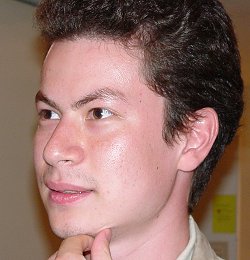 By
Joel Lautier
By
Joel Lautier"When it's your turn to play, how many moves do you calculate?" is a question grandmasters such as myself have been asked time and again by people showing an interest in the art of chess. Our answer would usually be: "Only one, but the right one!".
That is precisely the reason why Garry Kasparov can still fight today at equal odds with the best chess computers in the world, even though these machines are able to calculate four million positions in a second. This impressive number, however, is a but a drop in the ocean when applied to such a hugely complex game as chess. The mathematical possibilites of this ancient game are almost infinite and specialists have claimed that it would take several hundred years before a computer could solve the game entirely. The only way to do so would be to record every single possible position in chess on a gigantic hard disk, thus bringing a final answer to the eternal Shakesperean question facing every master as he sits in front of his chessboard: "In the initial position, is White to play and win or can Black hold the draw in all lines with best defence?" Until that enormous database is available, the best way to play chess is still to understand, rather than just calculate.
So why the fascination with these man versus machine matches? Isn't the machine simply using brute force and computing variation after variation of chess analysis, without any clue as to what it is really doing? Not quite. The speed of the processors and the size of its RAM are the machine's muscles, but it would still be helpless had it not a brain of its own. That brain is the playing algorithm, carefully chiseled by the programmer.

The battle between man and machine
Since every computer has a maximum calculating range, only the playing algorithm will enable the computer to eventually decide on a move. It will sort all the different lines the computer has calculated, compare them and play the one which scores highest on its evaluation scale.
As might be guessed, the algorithm makes the machine far more dangerous for the human player, but it also constitutes its Achilles' heel. In other words, by being granted life and intelligence, the chess-playing machine also becomes mortal and therefore vulnerable. Where there is human intervention, there is a rational logic behind it that can be grasped, as a result grandmasters have occasionally been able to foresee how a computer will act in a given position. If he is then able to find the one case where the machine's algorithm would be wrong, he can outwit the machine without the latter even realizing it, not until it is too late. And this holds true even if the programmer is a top-class player in his own right, with a deep understanding of the game. In other words, the best computer program with a playing algorithm carefully worked out by Garry Kasparov still wouldn't be certain to defeat the same Kasparov in a match. The game of chess is far too unpredictable to be solved by a set of rules, however craftily designed – there are just too many exceptions.
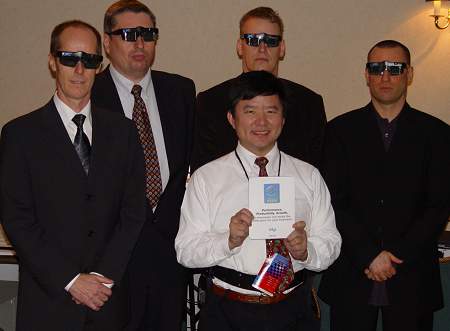
The "Men in Black" behind Fritz: Frans Morsch, Mathias Feist,
Jeroen van den Belt and Alex Kure, surrounding hardware specialist Alex Jao
of X3D Technologies.
But programmers have found other ways to rattle human opponents. As it turns out, predictability is not a defect that applies exclusively to machines, it is also a trait of human character. It is well-known that most players play less accurately when defending, or sometimes shy away from very open positions where many pieces are "hanging", particularly against computers. The grandmaster's nightmare, the one that sends cold shivers down his spine whenever he prepares to play a machine, has become true: the chess computers have begun to set traps. This means that it will intentionally go for moves that it does not assess as clearly better than others, but defines as more dangerous for human players to deal with.
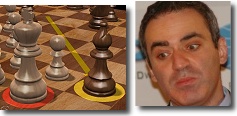 This
new milestone in chess programming was reached during the previous man versus
machine encounter when Kasparov faced the Israeli program Deep Junior.
During the penultimate game, in a fairly standard position, the computer unexpectedly
chose a speculative
piece sacrifice for no obvious compensation. It estimated that with Kasparov's
king under attack, there would be enough play to make up for the material deficit,
a common train of thought for a human but very unsettling when produced by
a machine, wouldn't you agree? No small part in this decision must have been
played by the fact that Kasparov is notoriously weaker in defence than in attack,
a fact the programmer was able to incorporate in Deep Junior's algorithm.
This
new milestone in chess programming was reached during the previous man versus
machine encounter when Kasparov faced the Israeli program Deep Junior.
During the penultimate game, in a fairly standard position, the computer unexpectedly
chose a speculative
piece sacrifice for no obvious compensation. It estimated that with Kasparov's
king under attack, there would be enough play to make up for the material deficit,
a common train of thought for a human but very unsettling when produced by
a machine, wouldn't you agree? No small part in this decision must have been
played by the fact that Kasparov is notoriously weaker in defence than in attack,
a fact the programmer was able to incorporate in Deep Junior's algorithm.
Suddenly, the human player had to face a mirror strategy to his own when fighting the machine: while the grandmaster searches for the human weakness in a machine's programming, the machine is being programmed so as to take advantage of all that is mechanical and automatic in a man's way of thinking. This parallel quest for artificial intelligence is what makes these matches so exciting today.
I will now give a brief account of the duel as it developed, before showing the two crucial positions that sealed the fate of the match.
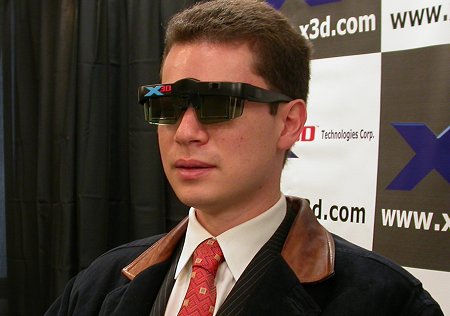
Joel Lautier testing the X3D glasses Kasparov used in the New York match
The match was held under the patronage of the high tech company X3D, which produces computer content in three dimensions to be displayed on the Internet. It took place in the posh salons of the New York Athletic Club, opposite Central Park. The current no.1 on the rating list, Garry Kasparov, was facing the latest product of the German company ChessBase, named X3D Fritz.
The first game was a messy affair, with Kasparov outplaying the computer in the opening stage with a typical pawn sacrifice, but failing to convert his advantage due to the computer's clockwork defence.
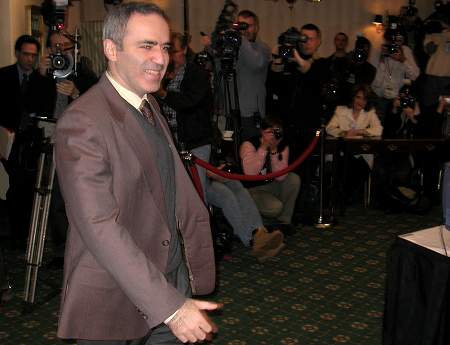
An optimistic Kasparov before game one of his match against X3D Fritz
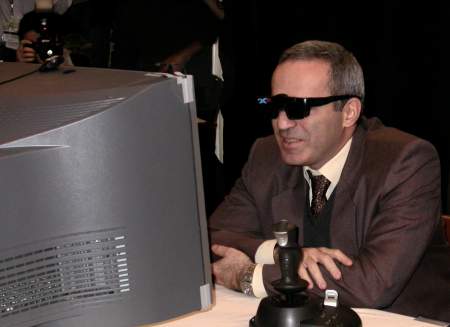
Ready to play, in the X3D virtual reality setup
The second game was a heartbreaker for Garry, as he had skillfully outmanoeuvred X3D yet again, only to blunder the game away in one move. As we shall see, there was an uncanny feeling that the computer had actually sensed the human champion could err exactly the way he did, for the tactical motif that caught Kasparov off-guard was very cunningly brought about by the machine.
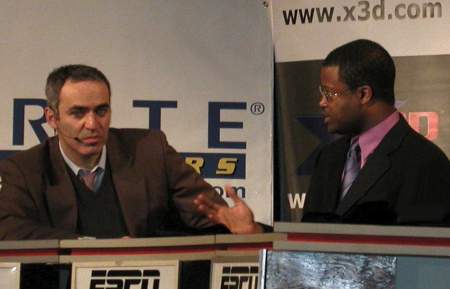
An exhausted and deeply disappointed Kasparov after game two
The third game was every grandmaster's dream, the computer entered an unfortunate opening scheme that left the position completely locked up. Unable to devise a long-term plan, the computer shuffled its pieces around aimlessly, while Kasparov was patiently amassing his pieces to deliver the winning blow. In a position it still assessed as inferior but not lost for itself, the computer was made to resign by an embarrassed team of programmers. The last game was a bit of an anti-climax, with Kasparov playing very prudently to secure a draw in the game and in the match overall.
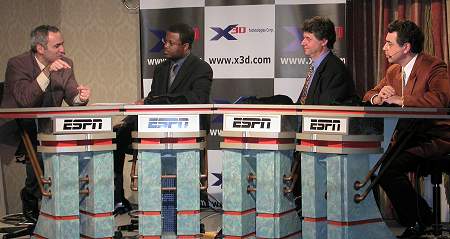
Postgame analysis on ESPN cable sports
Four games is too short a distance to gauge the players' relative strengths when they are so evenly matched. As a matter of fact, this encounter did not shed any new light on computer chess. The machine won and lost in the way we were accustomed to and Kasparov is right to say that he was dominating in most of the games. However, his extreme nervousness in facing machines has played tricks on him once more, and he wasn't able to capitalize on his better positions.
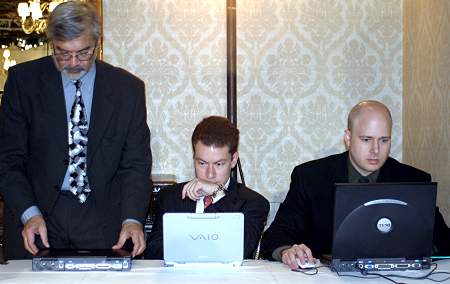
Joel Lautier (middle) assisting the ChessBase team (Frederic Friedel and
Mig Greengard) with the Internet commentary during Kasparov vs X3D Fritz in
New York
Here's a thought: how about giving other players a chance to play the best computers, then surely the current deadlock between man and machine would be broken? It has been the third match in a row to finish with a tie and crowds, especially in the US, want winners!
Let us now take a closer look at the two decisive games of the match.
X3D FRITZ – Kasparov,G (2830) [C66]
X3D Match New York USA (2), 13.11.2003 [Joel Lautier]
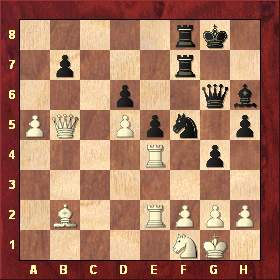
We join game 2 when Kasparov has just played 30...Bg7-h6. With adroit manoeuvring, Black has transformed a slightly worse position in the opening into a very promising attacking formation in the middlegame. Garry has managed to highlight a well-known weakness common to all chess programs: they consider a pawn expansion in front of one's own castled king (as is the case here for Black) a serious weakening of one's position, and thus wrongly assess the resulting positions. This problem is hard to solve, for if the algorithm is changed, then the computer might start sending his kingside pawns to the attack in all sorts of positions, including those where this would amount to a silicon hara-kiri. What makes the kingside pawn advance favourable to Black here is the fact that the centre is closed, and although clear to a human mind, this concept is a little loose in programming terms.
31.Qb6. Threatening to take the e5-pawn due to the hanging queen on g6. A preview of what is to come...
31...Kh7 32.Qb4.
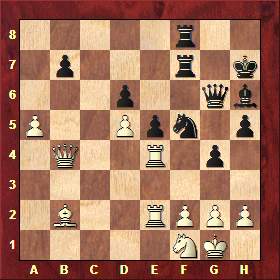
A very sly retreat, anticipating, as it were, Kasparov's blunder on the next move. This move has no purpose in itself, and Black would have kept a sizeable advantage had he continued with either 32...Rc8 taking control of the important c-file, or 32...Rg8 to protect g4 and keep pushing the pawns with 33...h4.
32...Rg7?? An amazing howler. Garry immediately realized his mistake after he'd played his move and kept shaking his head in utter disgust with himself. There is no arguing that Garry is still the best showman the chess world has to offer!
It's remarkable that in such cases, the computer doesn't pounce on the obvious winning move, but rather takes time as if to enjoy the moment. The few minutes that Kasparov waited for Damocles' sword to fall on him must have seemed like eternity. I was strongly reminded of the classic scene in "2001, a Space Odyssey", when the cosmonaut waits in anguish for the spaceship door to open, already sensing that the main computer has taken control and won't let him back in.
33.Rxe5. Suddenly Black's rook on f8, which was defended three times two moves ago, is now found hanging.
33...dxe5 34.Qxf8. The rest is a trivial win for White. 34...Nd4 35.Bxd4 exd4 36.Re8 Rg8 37.Qe7+ Rg7 38.Qd8 Rg8 39.Qd7+ 1-0.
Kasparov,G (2830) – X3D FRITZ [D45]
X3D Match New York USA (3), 16.11.2003 [Joel Lautier]
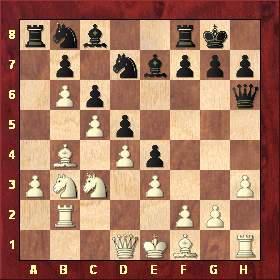
Position after 21.Na5-b3
 After
a calamitous opening in the third game, the computer has reached a position
with a pawn down but still not devoid of counterchances. Any human player would
have lashed out here with 21...f5 to follow up with 22...f4. If White stops
this idea with 22.g3, then 22...g5! puts ...f4 right back on the agenda.
After
a calamitous opening in the third game, the computer has reached a position
with a pawn down but still not devoid of counterchances. Any human player would
have lashed out here with 21...f5 to follow up with 22...f4. If White stops
this idea with 22.g3, then 22...g5! puts ...f4 right back on the agenda.
Once again, the computer's algorithm dictates that pawns in front of a castled king should not be pushed, especially when White's king isn't castled on the same side. It takes human insight to see that with the center completely blocked, not only are these pawn advances desirable for Black, they represent the only chance to save the game.
I'm surprised that the programmers allowed their computer to enter such a closed position. What is the point of caging such a terrifying beast behind walls where it can't make any use of its fabulous powers? Kasparov does a perfect job of shooting down this imposing sitting target, but truly a child could have done it.
21...Bh4 22.Qd2 Nf6 23.Kd1. First part of the plan: evacuate the king to safety.
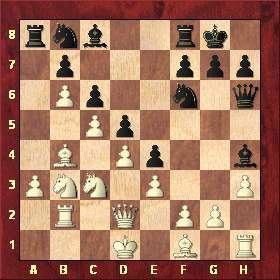
23...Be6 24.Kc1 Rd8 25.Rc2 Nbd7 26.Kb2 Nf8 27.a4. Second part of the plan: send the extra pawn as a battering ram to create a winning passed pawn on b6.
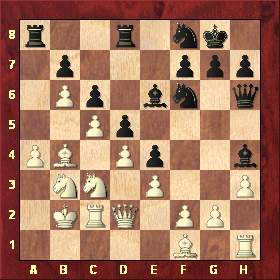
27...Ng6 28.a5 Ne7 29.a6 bxa6 30.Na5. Third part of the plan: occupy all the good squares and bring maximum pressure on Black's pawns at a6 and c6.
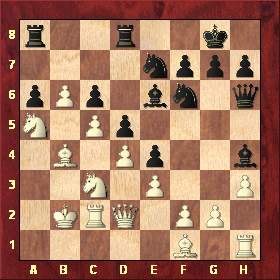
30...Rdb8 31.g3 Bg5 32.Bg2 Qg6 33.Ka1 Kh8 34.Na2 Bd7 35.Bc3 Ne8 36.Nb4 Kg8 37.Rb1 Bc8 38.Ra2 Bh6 39.Bf1 Qe6 40.Qd1 Nf6 41.Qa4. Third part completed: Black can't defend both c6 and a6. It's harvest time.
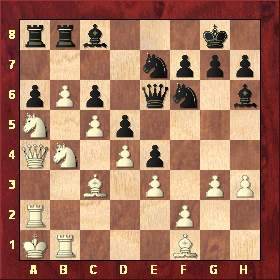
41...Bb7 42.Nxb7 Rxb7 43.Nxa6 Qd7 44.Qc2 Kh8 45.Rb3 and here the X3D Fritz team threw in the towel, having seen enough carnage in one day. 1-0.